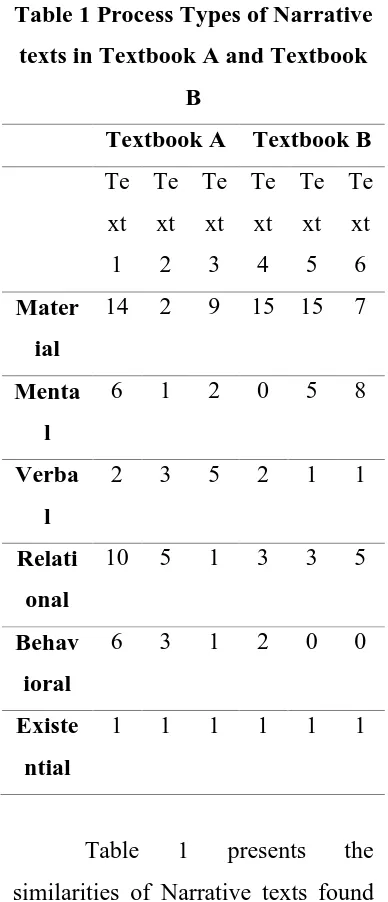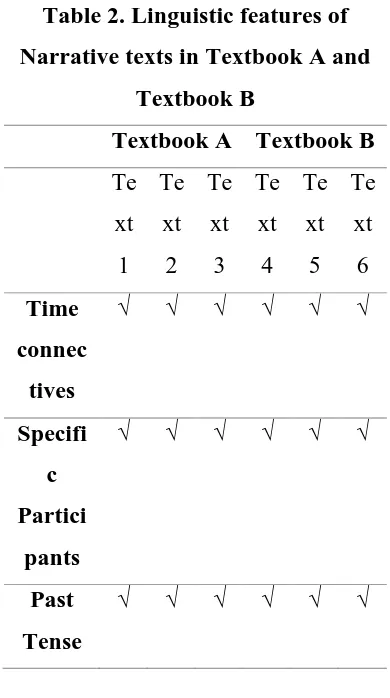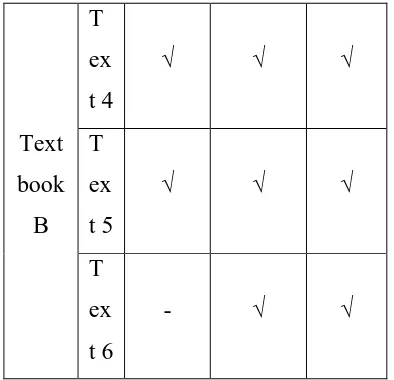115
AN ANALYSIS OF NARRATIVE TEXTS IN TEXTBOOKS
USED BY EIGHTH GRADE STUDENTS
(Systemic Functional Linguistics Perspective)
Veronika Titin Suhartini [email protected]
Department of English Education, Indonesia University of Education
Abstract: This paper entitled “Analysis of Narrative Texts in Textbooks Used by Eighth grade Students (Systemic Functional Linguistics Perspective)” is aimed to reveal to what extent Narrative texts in two selected English textbooks fulfill the criteria of Narrative text and to find out the similarities and differences of Narrative texts between two selected English textbooks. The study employed descriptive qualitative method. The data were in this study were six Narrative texts taken from two selected textbooks. The data analysis was done by investigating schematic structure, social purpose and linguistic features by using Transitivity system. The results of analysis show that in some extent (1) four out of six Narrative texts have fulfilled the schematic structure criteria namely
Orientation, Complication, and Resolution; (2) five out of six Narrative texts fulfill the social purposes; and (3) six out of six Narrative texts fulfill the linguistic features. To sum up, Narrative texts in two textbooks are similar in terms of linguistic features and process types, whereas the differences were found in terms of social purpose and schematic structure.
Keywords: Narrative text, SFL, Transitivity system, linguistic features, schematic structure, social purpose
Introduction
Texts are important means of
education since texts are used as
educational materials in schools and
have a crucial place in language
education. There are several types of
text such as Recount, Report,
Exposition, Discussion, Narrative
and Descriptive texts (Christie &
Derewianka, 2010; Knapp &
Watkins, 2005; Emilia, 2011).
In addition, since the Educational
Unit Curriculum (KTSP) 2006
requires eighth grade students to
comprehend Narrative text, and
textbook that is used for educational
purpose should orient towards the
National Curriculum, English
textbook that is used for teaching
learning process should provide a
good example of Narrative text.
116
language content in textbook,
Narrative texts in the textbook can be
analyzed by using experiential
metafunction in Systemic Functional
Linguistic (SFL) framework since it
views how language is used to
construe the meaning in social
settings (Halliday, 2004). SFL,
especially Transitivity system, is used
as a tool to analyze the Narrative
texts because it perceives language
not only as a set of rules but also
concerns on how language serves as
a resource for making and
exchanging system of meaning
(Halliday, 2004; Eggins, 2004).
This study is aimed to analyze
Narrative texts in two selected
English textbooks used by eighth
grade students by using Transitivity
system. This study is expected to
discover whether the texts have
fulfilled the criteria as a good
example of Narrative texts in terms
of social purpose, schematic
structure and linguistic features.
Literature Review
Narrative text is a type of text
talking about a series of event that
happened to a person or a character
(Knapp & Watkins, 2005; Gerot &
Wignell, 1994). The character can be
a person, animal, plant or thing
(Christie & Derewianka, 2010;
Knapp & Watkins, 2005; Emilia,
2011). It aims to entertain, to get and
retain the attention of the reader or
listener of the story, to teach lesson,
to explore social values and moral
values (Gerot & Wignell, 1994;
Emilia, 2004). The simple structure
of the narrative text is orientation,
complication, and resolution (Gerot
& Wignell, 1994; Knapp & Watkins,
2015). Some linguistic features of the
narrative texts are presented as
follows (adapted from Emilia, 2004;
Primary National Strategy; Knapp &
Watkins, 2015; p. 321; Gerot &
Wignel, 1994, p.16):
a. The story is written in the
first person (I, we) or third
person (she, he, and they).
b. The verbs are in past tense.
For example: One day a
man and his son went to the
jungle to hunt deer.
c. Chronological (plot or
content have a chronology
of events that happened in a
117
that it is sequenced in time
and use time connectives;
once upon a time, after a
while, then, finally.
Connectives are widely used
to move the narrative along
and to affect the reader.
d. Main participants are
characters with recognizable
qualities, are often specific
and individual
e. The processes that mostly
occur in this kind of text is
material, verbal and mental.
Since there are some processes exist
in narrative texts, Transitivity system
is used as a tool for analyzing
processes that emerged in the text.
Transitivity system has six types of
processes (Halliday, 2004; Eggins,
2004; Emilia, 2014). Those processes
are material, mental, verbal,
relational, behavioral, and existential.
All these types are different and have
their own grammar. Each process in
transitivity system consists of three
principle components which are
process, participant and circumstance
(Halliday, 2004; Eggins, 2004;
Emilia, 2014). Below is an example
of processes:
Methodology
The method used in this study
was qualitative method using
document analysis technique. The
subject of this study was Narrative
texts derived from two selected
English textbooks used for eighth
grade students. The focus of the
study is on analyzing Narrative texts
chosen from two selected English
textbooks. There were three
Narrative texts from each textbook
that were analyzed using SFL
framework in order to identify their
criteria in term of social purpose,
schematic structure and linguistic
features.
Data Presentation and Discussion
In terms of social purpose,
five out of six Narrative texts have
Partici
pant
Proc
ess
Partici
pant
Circumst
ances
The
boys
Play footbal
l
in the
118
fulfilled the criteria as a Narrative
text. There are two social purposes
of Narrative text; to entertain the
reader and to tell an imaginary story.
All texts from two selected textbooks
have fulfilled the first social purpose.
They can entertain the readers and
telling stories in a sequence of events
(Gerrot & Wignel, 1996; Knapp &
Watkins, 2005). For the second
social purpose, five out of six
Narrative texts have achieved the
criteria to tell an imaginary story
since the characters are animal. Text
1 from textbook A did not reach the
second social purpose of narrative
text, to tell an imaginary story,
because the character, the events, and
the place were not imaginary or real.
In term of schematic
structure, the research shows that
four from six texts have fulfilled
three elements of Narrative text
which are Orientation, Complication,
and Resolution (Knapp & Watkins,
2015). However, from the six
Narrative texts, Text 2 derived from
Textbook A did not provide any
Resolution which indicates the
problem is not solved and the story
has not come to an end. Text 2 did
not fulfill the criteria of schematic
structure as suggested by Christie
and Derewianka (2010), Emilia
(2010), Knapp and Watkins (2005)
since it only provided two out of
three elements which are Orientation
and Complication. Moreover, from
textbook, there is Text 6 which also
has not met the fulfillment of
schematic structure since it did not
provide appropriate Orientation.
In terms of linguistic features,
it is demonstrated that Narrative texts
from both Textbook A and Textbook
B have already employed the
appropriate linguistic features
required by Narrative texts such as
the use of time connectives, specific
participant, Past Tense, and the
existence of material, verbal and
mental processes (Halliday, 2004).
From the analysis and
explanation above, it is found that
Narrative texts from both textbooks
provide similarities and differences.
For the similarities, it is found that
all Narrative texts derived from
Textbook A and Textbook B are
written in third person point of view
since all of the characters or
119
(Halliday, 2004). Besides that, the
similarities between Textbook A and
Textbook B can be found in the
process type and the linguistic
features of the Narrative text. The
description is presented in the
following table.
Table 1 Process Types of Narrative
texts in Textbook A and Textbook
B
Textbook A Textbook B
Te
similarities of Narrative texts found
in Textbook A and Textbook B. As
verbal processes (Christie &
Derewianka, 2010; Halliday, 2004;
Gerot & Wignell, 1996). Besides the
processes required, there is also an
occurrence of other processes such as
relational and existential processes.
Relational processes are processes of
being (Halliday, 2004, Emilia, 2014)
while existential processes are
processes that represent experience
which shows that something exists or
happens (Halliday, 2004; Emilia,
2014). These existential processes
occur in Orientation. It similarly
happened in all of Narrative texts in
two textbook. In addition, the
similarities of Narrative texts
between Textbook A and Textbook
B can be found in the linguistic
features as can be seen from the table
120
Table 2. Linguistic features of
Narrative texts in Textbook A and
Textbook B
Textbook A Textbook B
Te
Textbook B have achieved all criteria
of linguistic features. Narrative texts
in both selected textbooks have used
the time connectives which shows
the story is written chronologically
(Knapp & Watkins, 2005).
Moreover, all of Narrative texts also
employed the specific participants.
This is related to the processes
occurred in the texts. As mentioned
by Halliday (1994, cited in Emilia,
2014, p. 150) that process usually
consists of three elements;
participant, process itself, and
circumstance. In addition, the
Narrative texts in two selected
textbook have used past tense as the
verb in each clause.
Apart from the similarities,
there are also differences found in
the Narrative texts between Textbook
A and Textbook B. Narrative texts in
both selected textbooks are different
in term of schematic structure and
social purpose. The analysis of
schematic structure in Narrative texts
from Textbook A and Textbook B is
presented in the table below.
Table 3. The Schematic structure
of Narrative texts in Textbook A
and Textbook B
121
difference of Narrative texts between
two selected English textbooks.
From the table, it is shown that one
out of three Narrative texts in
textbook A did not provide
Resolution. Meanwhile, in Textbook
B there is one Narrative text did not
achieve the criteria of Orientation.
Moreover, Narrative texts in
Textbook A and Textbook B are
different in term of social purpose.
The analysis of difference is
presented in the following table.
Table 4. The Social purpose of
Narrative texts in Textbook A and
Textbook B
Table 4 indicates that
Narrative texts in Textbook A and
Textbook B have achieved the first
purpose of Narrative texts which is to
entertain the reader (Knapp &
Watkins, 2005). It is obtained from
the stories which are written
chronologically and intended to tell a
story in sequence of events.
However, there is a Narrative
texts in Textbook A that does not Purpo
ses
Textbook A Textbook B
122
achieve the second purpose of
Narrative text which is to tell an
imaginary story. There are some
criteria for Narrative text to be
identified as an imaginary story. It is
seen from the imaginative characters,
events, and places. Since the
characters of Text 2, 3, 4, 5, and 6
are animals which can be categorized
as imaginative character, the
characters of Text 1 are real human
and did not indicate any imaginative
character so that Text 1 did not tell
an imaginary story
From the description, it can
be inferred that Narrative texts in
Textbook A and Textbook B have
shown similarities and differences.
Narrative texts in Textbook A and B
are similar in terms of Process Types
and Linguistic features. While the
differences of Narrative texts in
Textbook A and Textbook B are
found in the schematic structure and
social purposes.
Conclusions
The findings of this study
indicated that in some extent, most of
Narrative texts from the two selected
English textbooks have fulfilled the
criteria of Narrative texts in terms of
schematic structure, social purpose
and linguistic features. The Narrative
texts between two textbooks also
show differences and similarities.
Narrative texts in textbook A and
textbook B are similar in terms of
linguistic features and process types.
However, Narrative texts in textbook
A and B are different in terms of
social purpose and schematic
structure since one of three texts in
Textbook A did not provide
Resolution while one of three text in
Textbook B did not provide the
Orientation.
References
Christie, F., & Derewianka, B.
(2010). School discourse.
British: Continuum.
Eggins, S. (2004). An introduction to
systemic functional linguistics..
New York: Continuum.
Emilia, E. (2014). Introducing
functional grammar. Bandung:
Pustaka Jaya
Emilia, E. (2011). Pendekatan genre
based. Petunjuk untuk guru.
123
Gerot, L. & Wignell, P. (1994).
Making sense of functional
grammar. Cammeray: Gerd
Stabler.
Halliday, M.A.K. (2004). An
introduction to functional
grammar. 3rd edition. London:
Arnold
Knapp, P., & Watkins, M. (2005).
Genre, text, and grammar.
technology for teaching and
assesing writing. Sydney:
University of New South


